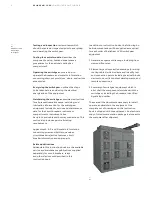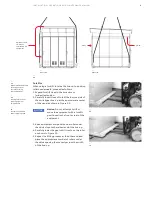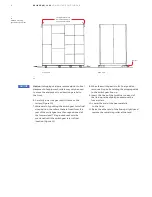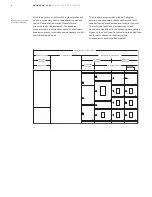
18
I N S TA L L AT I O N , O P ER AT I O N S A N D M A I N T EN A N C E M A N UA L
The cradle draw-out rails, item 2 in Figure 19,
engage the racking mechanism, item 1 in Figure 20,
on the sides of the breaker. The breaker is pulled
into the compartment and locked in its final
connected position through the operation of the
racking handle.
The breaker should always be OPEN when it is
moved into or out of the CONNECTED position.
As a safeguard, a draw-out interlock will prevent
operation of the racking mechanism unless the
breaker is OPEN.
All SACE Emax 2 circuit breakers are provided
with a mechanical rejection feature. See section
5 of this instruction book for additional details.
Each circuit breaker compartment has four
positions as described in the Table 1.
Movement of the breaker between the
CONNECTED, TEST, and DISCONNECTED positions
is performed by the use of a racking handle, see
Figure 22, which engages the racking mechanism
mounted on the circuit breaker. An optional
remote racking device is also available.
Movement to the WITHDRAWN position is manually
performed after opening the compartment door.
These positions are illustrated and described more
fully in Section 5 of this instruction book.
Warning:
The door should NOT be
opened when the circuit breaker is
closed and in the CONNECTED
position. Although the breaker
compartment door may be opened in
any position, it is recommended that
the door only be opened when the
breaker is in the DISCONNECTED or
WITHDRAWN position.
The dedicated front-mounted auxiliary ventilated
compartment is constructed with grounded metal
barriers on all sides resulting in a segregated
compartment thus protecting operators from
gases which may be vented by the breaker during
circuit interruption.
Circuit breaker
position in
the cassette
Primary
disconnects
Secondary
disconnects
Shutter
assembly
Circuit breaker functionality
Circuit breaker
door position
Connect
Engaged
Engaged
Opened
• Breaker can be operated mechanically or
electrically.
• Breaker ready for service.
Closed
Test
Disengaged
Engaged
Closed
• Breaker can be operated mechanically or
electrically.
• Breaker and control circuits operations can
be tested and verified.
Closed
Disconnect
Disengaged
Disengaged
Closed
• Breaker can be operated only mechanically.
• Breaker cannot be removed from the circuit
breaker compartment.
Closed
Withdrawn
Disengaged
Disengaged
Closed
• Breaker can be operated
only mechanically.
• Breaker can be removed from
the compartment.
Open
Table 1 - Description of the circuit breaker positions
1
1. Breaker position indicator
2. Racking handle
—
22
Racking handle for
movement of Emax
2 circuit breakers
—
22
2
DANGER
WARNING
CAUTION
NOTICE
















































